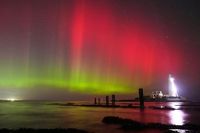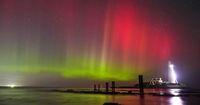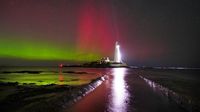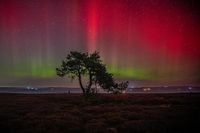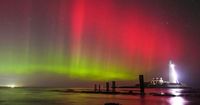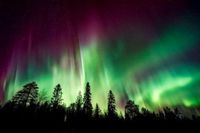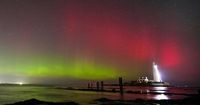The Northern Lights will transform the typically gloomy skies above the UK with streaks of pink, purple, and green this week. The night sky phenomenon, or aurora borealis, are flashes of colour that mainly appear in the northernmost regions of the planet, like Canada. But a geomagnetic storm that has raged for months has made this celestial fireworks display visible further south – even in London. The Met Office says that the Northern Lights will be visible in the UK this week – and for a good while. Here’s everything you need to know.
What are the Northern Lights? Wrapped around the Earth is something called the magnetic field. Think of it like cling film wrapped around an apple that helps keep worms away. Thankfully, we don’t need to worry about any space worms coming for us. Instead, the field shields us from the plasma the sun spits out, called solar wind. Some of those energy particles splatter over the Earth and cause a disturbance in our planet’s magnetic field, known as a geomagnetic storm. If that storm is strong enough, the aurora borealis becomes visible.
Probably! The Met Office says a burst of solar activity means the aurora will dance above northern Scotland. On the weather agency’s ‘space weather’ forecast (yes, really), it says: ‘There is a chance of aurora sightings at times across northern Scotland this week, given clear night-time skies, with a slight chance of sightings across Southern Scotland and similar latitudes.’ There’s a good chance they’ll be visible elsewhere in the UK. In the early hours today, for example, Northern Lights chasers saw the neon spaghetti above Whitley Bay, a seaside town in North Tyneside. A big stream of this sun gunk, called solar wind, will reach us today and last until Friday.
Why is the UK seeing the Northern Lights? The sun’s magnetic field flips every 11 years, the peak of which is known as the solar maximum, Tom Kerss, an astronomer and author once dubbed ‘Chief Aurora Chaser’, told Metro. ‘With the arrival of solar maximum starting in October last year, we’ve had a super season of aurora-chasing,’ he said. ‘And the good news is that heightened solar activity brings an increased chance of sightings at UK latitudes, particularly in Scotland.’ Kerss says that a large coronal hole that coughs up all sorts of high-speed gunk called solar wind is now facing the Earth. ‘You can think of this as somewhat analogous to aeroplane turbulence,’ he added. ‘Where the solar wind speed changes – a region called the stream interface – the space weather is choppy. This is very favourable for the development of bright and dynamic auroras, and this enhanced solar wind also influences the range of latitudes at which they can be seen, bringing them farther south.’ Being so close to the Spring equinox also helps. ‘In late March, as in late September, the alignment of the Earth’s magnetic field is particularly good,’ he said. ‘So there’s a nice confluence of solar activity and our orbit that will hopefully pay off for budding aurora hunters.’
There’s something utterly unique about seeing the auroras yourself,’ Kerss said. ‘They show a subtlety and softness that’s hard to define, yet they’re also distinctly self-luminous and evidently enormous.’ It’s something that many people will, of course, be eager to take photos of. ‘Even a smartphone can now reveal a striking range of colour that our eyes aren’t sensitive enough to see vividly,’ Kerss added. ‘Today’s smartphones capture remarkably good shots of the night sky, including the Northern Lights. You’ll need to ensure night mode is enabled. ‘On the iPhone, it’s automatically on when a yellow bubble appears in the corner. On Android, you can select it manually. It takes several seconds to capture a photo, so hold still, or use a tripod if you have one. For larger cameras, you can achieve longer exposures, but you’ll need to use your fastest and widest lens. Set the focus to manual and use a bright star or planet to achieve perfect focus for the Lights. Experiment with the ISO (at least 800) and exposure (several seconds or more) settings until the images appear bright enough. Shoot in raw so you can edit these later to reveal more colour.
AuroraWatch UK, a Lancaster University service that monitors the phenomenon, recorded recent ‘significant activity’ at 2am last night. It’s quietened since but similar services like VeryWeather show an ‘aurora storm’ is rumbling. The Northern Lights are expected to be visible in the UK this week, specifically around 2025-03-26, due to a geomagnetic storm. The Met Office forecasts a chance of aurora sightings across northern Scotland this week, with a slight chance in Southern Scotland. On 2025-03-26, the Northern Lights were seen above Whitley Bay, North Tyneside. The solar maximum, which started in October 2024, has increased the chances of seeing the aurora in the UK. A large coronal hole is causing high-speed solar wind, increasing the visibility of auroras further south.
Britons were treated to the spectacular sight of the northern lights – or aurora – lighting the skies in some unusual parts of the country this week. While sightings of the aurora borealis are most common in Scotland, on Tuesday night areas further south were able to enjoy the astronomical phenomena. The lights were visible in Whitley Bay and Tyne and Wear early on 2025-03-26, where skies remained clear. A partial solar eclipse will also be visible in parts of the UK this weekend, but cloudy and rainy days could hamper those wishing to catch a glimpse. The phenomenon occurs when the moon passes between the sun and the Earth. The three will not be completely aligned, meaning only part of the Sun will be obscured.
A red alert was issued on 2025-03-26 by Aurorawatch UK, indicating that aurora will likely be visible by eye and camera from anywhere in the UK. The Met Office Space Weather forecasting service said there is a chance of aurora sightings at times across northern Scotland this week, from 2025-03-26 to around 2025-03-28. The best time to watch the Northern Lights is potentially after 8pm on 2025-03-26, assuming the sky remains cloud-free. The brightest aurora are typically around 11pm to midnight local time. The Sun is currently at a “maximum” in its 11-year solar cycle.
The auroras on Earth, which are most commonly seen over high polar latitudes but can spread south, are chiefly influenced by geomagnetic storms which originate from activity on the Sun. The sun works on a cycle of around 11 years called the solar cycle – with peak sunspot activity on the surface of the Sun referred to as solar maximum. This means there are lots of sunspots on the surface which are a bit like volcanoes and occasionally erupt. These are known as Coronal Mass Ejections (CME’s) and release extra material and energy out into space. If directed towards Earth, our magnetic field pulls the energy into our atmosphere at the poles. Once the energy is in our atmosphere, reactions with oxygen and nitrogen then bring the colours we associate with the aurora.
The best months to see the Northern Lights are September to late March, as these months have the longest dark hours and best viewing conditions. The best places to see the Northern Lights in the UK are Scotland, Northern Ireland, and northern England. However, they have on occasion been spotted in the south of England. They could be visible in parts of Scotland tonight. The best sightings of the Northern Lights are when the skies are darkest - normally around midnight.
In North America, there's a reduced chance of seeing the aurora tonight, although people in Canada and Alaska may catch a glimpse. The National Oceanic and Atmospheric Administration (NOAA) has rated it 'G0' on a scale of one to five, meaning it will be far north, quite dim in intensity, and not very active. Meanwhile, in the southern hemisphere – where it's known as aurora australis – the spectacle could be seen across Tasmania and Southern New Zealand in clear skies.
Although not dangerous to humans, the particles can damage power grids on Earth and satellites in orbit, which can lead to internet disruptions. 'Harmful space weather has affected Earth before, but as we become increasingly reliant on systems and technologies vulnerable to the Sun's outbursts, future solar impacts could be even more disruptive,' says the European Space Agency (ESA).
